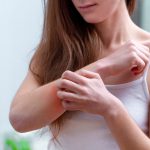Ashwagandha in Sanskrit means “smell of the horse” to correlate it with the strength of…
Read MoreWho doesn’t dream of having beautiful, radiant, healthy skin glow? According to Ayurveda, maintaining the beauty of your skin involves balancing the three doshas – Vata, pitta, and Kapha. Proper functioning of
Natural ways to improve skin glow are making the proper diet and lifestyle choices. Glowing skin has different meanings for different people. Ideally, skin glow generally refers to’ alive’ skin with a natural shine that is not dull and dry. Typical characteristics of skin glow are:
But remember that even the most glamourous skin glow has its faults with visible pores, wrinkles, marks, etc. So don’t kill yourself for that flawless look.
If you follow a simple cleansing, moisturizing routine daily while applying sunscreen, you could save money spent at the parlor. Cleanse with a mild, pH-balanced cleanser to remove everyday impurities and oil from your skin. Immediately after cleansing, moisturizing with an oil-free moisturizer locks in the moisture, leaving your skin hydrated. Use a mineral-based, broad-spectrum SPF sunscreen to prevent skin damage from harmful UV radiations.
You could also try natural collagen supplements for skin and give yourself regular facial massages, apart from this daily routine. Consume a fiber-rich, nutrient-dense diet, incorporate healthy fats from nuts and seeds in your diet, and choose fruits and vegetables rich in antioxidants that prevent oxidative stress. Avoid sugary foods and dairy products, engage in physical activity, and stay hydrated.
Most of us depend on regular parlor visits to maintain our skin when all we need is to open our kitchen cabinets. Did you rue the weekends when your mother or grandma applied some besan, chandan, or banana peel on your face? What seemed stinky and gooey was heavenly for your skin glow.
The traditional homemade skin pack recipes are still applicable. But, we should be wary of the endless recipes floating on the internet. Also, when it comes to your body, especially the skin, do not experiment with herbs and other ingredients yourself.
Done right and with the right ingredients and in the right proportions, homemade skin packs are all you need for that glam, glowing look. These natural herbs and foods contain antioxidants and essential vitamins like A, C, and E that prevent skin damage from oxidative stress. They also cleanse and moisturize the skin naturally while gently exfoliating the skin. While you improve the quality of your diet, these homemade skin packs will prevent premature aging signs like wrinkles, fine lines, and other blemishes.
Ayurveda incorporates skincare elements into the daily routine (dinacharya), taking care to tweak the routine according to the season. Ayurvedic literature offers a treasure trove of herbs and other natural ingredients that can benefit your skin glow. Let’s take a look at a few home remedies that can offer you radiant, beautiful skin glow.
In Ayurveda, mulethi or licorice is characterized as a ‘varnya’ herb. That is, it improves your complexion and the texture of your skin. Research indicates that it:
A common spice found in almost every kitchen, turmeric can do wonders for your skin glow. According to Ayurveda, it can balance all three doshas – vata, pitta, and kapha.
Pomegranates are famed for their many health benefits. They’re great for your heart and can lower cholesterol levels and blood pressure. Ayurveda says sweet pomegranate helps balance all three doshas – vata, pitta, and kapha. However, sour pomegranate balances vata and kapha, but aggravates pitta. They are thought to improve digestion, treat certain kinds of fever, and improve your complexion. Let’s take a look at what these juicy fruits can do for your skin glow. Pomegranates:
Asparagus racemosus or Shatavari has always been valued for its medicinal properties. But do keep in mind that this is not the asparagus that’s usually eaten as a vegetable. That’s Asparagus Officinalis.
Shatavari is considered a female tonic in Ayurveda, and it’s used to treat a range of conditions from dysentery to conjunctivitis.[12]Hasan, Noorul, Nesar Ahmad, Shaikh Zohrameena, Mohd Khalid, and Juber Akhtar. “Asparagus racemosus: For medicinal uses & pharmacological actions.” International Journal of Advanced … Continue reading So, how does it help your skin glow? It
Delicious, easy to eat bananas can also be good for your skin glow. They
Frankincense has been valued in traditional medicinal systems for its expectorant, anti-inflammatory, and antiseptic properties.[18]Al-Yasiry, Ali Ridha Mustafa, and Bożena Kiczorowska. “Frankincense-therapeutic properties.” Advances in Hygiene & Experimental Medicine/Postepy Higieny i Medycyny Doswiadczalnej 70 … Continue reading It offers great benefits for your skin glow too. Frankincense essential oil, which is obtained from the resin of the frankincense tree, can
According to Ayurveda carrots are easy to digest(laghu) with sweet (madhura) and bitter (tikta) rasa or taste. As children, we’ve all been told that carrots are good for your eyes. But did you know that they’re good for your skin too? Here’s what carrots can do for your skin glow. They:
Gram flour or besan is prepared by grinding chickpeas into a fine powder. According to Ayurveda, it balances pitta and kapha dosha while increasing vata dosha. It
Yogurt contains lactic acid, an alpha-hydroxy acid widely used in skincare. It
Papayas can be diced into a salad or added to smoothies or soups for a great shot of flavor. According to ayurveda, they balance pitta and vata while increasing kapha dosha. This fruit:
Acai berries are native to South America and have quite a reputation as a ‘superfood’. These berries can also work wonders for your skin glow. They
Ageless glowing skin is soft, supple, and warm to the touch. Incorporating the right lifestyle and diet changes can literally add years to your skin glow. Choose the right herbs and ingredients to make simple homemade face packs. You can also adopt natural supplements for skin glow. Your skin will thank you and reward you back for this nourishing care.
Very effective. Homemade face masks use natural ingredients like fruits, herbs, etc., that get easily absorbed by the skin. These face masks can cleanse, moisturize and exfoliate your skin naturally and make your skin glow. Ensure that you choose the right recipes and pure ingredients. Also, do a small patch test on your skin before applying it to your face.
Daily. Some face masks can also be applied twice a week, weekly, fortnightly, or monthly. The frequency of application depends upon the action of the face mask, ingredients used, and the skin issue that you are tackling. You can apply a cleanser and moisturizer daily using gentler ingredients. If you are treating chronic issues like acne, then applying the face mask for a week daily might be required. As with everything, moderation is the key. Nourish the skin and allow it to heal naturally.
Yes. You can. Based on the ingredients, skin issues, and season you can choose to apply a face mask daily. For oily skin, cleansing might be needed daily or moisturizing during the dry season. Take breaks after a week’s application to see the results and make changes accordingly. Take special care with ingredients that are known to be abrasive or harsh on the skin.
Yes. Everyone can use face masks as a preventative and curative skincare routine. Try doing a skin patch test to check for allergies or reactions to specific ingredients. Discard the face mask recipe if you experience redness, burning, or inflammation on the skin patch. For chronic conditions, consult a dermatologist or medical practitioner.
Remove the face mask and discard the prepared recipe. Try making changes to the recipe and doing a skin patch test to see if the problem persists. You can also consult a dermatologist or medical practitioner to understand what ingredients work and do not work for your specific skin type and ailment.
People with sensitive skin should be careful before applying a face mask. Even though natural, some ingredients can be irritating to your skin. Do an allergy test or even a skin patch test to ascertain if a certain face mask recipe will work for you.
People with sensitive skin, people who are allergic to certain foods like herbs, fruits, dairy products, animal products like honey, etc. Consult with your doctor before starting with new ingredients. Perform a simple skin patch test to check for allergic reactions to ingredients. For chronic skin disorders like eczema, psoriasis, dermatitis, etc., seek medical advice rather than experimenting with homemade skin recipes.
References
| ↑1 | [ Atopic Dermatitis](https://www.niams.nih.gov/health-topics/atopic-dermatitis#tab-overview “Atopic Dermatitis”). National Institutes of Health. |
|---|---|
| ↑2 | Saeedi, Muadhamm, K. Morteza‐Semnani, and M‐R. Ghoreishi. “The treatment of atopic dermatitis with licorice gel.” Journal of Dermatological Treatment 14, no. 3 (2003): 153-157. |
| ↑3 | Yokota, Tomohiro, Hiroyuki Nishio, Yasuo Kubota, and Masako Mizoguchi. “The inhibitory effect of glabridin from licorice extracts on melanogenesis and inflammation.” Pigment cell research 11, no. 6 (1998): 355-361. |
| ↑4 | Raoufinejad, Kosar, and Mehdi Rajabi. “Licorice in the Treatment of Acne Vulgaris and Postinflammatory Hyperpigmentation: A Review.” Journal of Pharmaceutical Care (2020). |
| ↑5 | Sumiyoshi, Maho, and Yoshiyuki Kimura. “Effects of a turmeric extract (Curcuma longa) on chronic ultraviolet B irradiation-induced skin damage in melanin-possessing hairless mice.” Phytomedicine 16, no. 12 (2009): 1137-1143. |
| ↑6 | Tu, Cai‐Xia, Mao Lin, Shan‐Shan Lu, Xiao‐Yi Qi, Rong‐Xin Zhang, and Yun‐Ying Zhang. “Curcumin inhibits melanogenesis in human melanocytes.” Phytotherapy Research 26, no. 2 (2012): 174-179. |
| ↑7 | Dueep Singh, John Davidson. Introduction to Ayurveda – Keeping Healthy the Ancient Way. Mendon Cottage Books. 2015 |
| ↑8 | Kang, Su‑Jin, Beom‑Rak Choi, Seung‑Hee Kim, Hae‑Yeon Yi, Hye‑Rim Park, Chang‑Hyun Song, Sae‑Kwang Ku, and Young‑Joon Lee. “Beneficial effects of dried pomegranate juice concentrated powder on ultraviolet B-induced skin photoaging in hairless mice.” Experimental and therapeutic medicine 14, no. 2 (2017): 1023-1036. |
| ↑9 | Reilly, David M., and Jennifer Lozano. “Skin collagen through the life stages: Importance for skin health and beauty.” Plastic and Aesthetic Research 8 (2021). |
| ↑10 | Henning, Susanne M., Jieping Yang, Ru-Po Lee, Jianjun Huang, Mark Hsu, Gail Thames, Irene Gilbuena et al. “Pomegranate juice and extract consumption increases the resistance to UVB-induced erythema and changes the skin microbiome in healthy women: A randomized controlled trial.” Scientific reports 9, no. 1 (2019): 1-11. |
| ↑11 | [What Is Pomegranate Juice?](https://www.verywellhealth.com/pomegranate-juice-may-interact-with-certain-medications-89171 “What Is Pomegranate Juice?”). Verywell Health. |
| ↑12 | Hasan, Noorul, Nesar Ahmad, Shaikh Zohrameena, Mohd Khalid, and Juber Akhtar. “Asparagus racemosus: For medicinal uses & pharmacological actions.” International Journal of Advanced Research 4, no. 3 (2016): 259-267. |
| ↑13 | Rungsanga, Tammanoon, Punpimol Tuntijarukornb, Kornkanok Ingkaninanc, and Jarupa Viyocha. “Stability and clinical effectiveness of emulsion containing Asparagus racemosus root extract.” Science Asia 41, no. 4 (2015): 236-245. |
| ↑14 | Therdphapiyanak, Narin, Montree Jaturanpinyo, Neti Waranuch, Lalana Kongkaneramit, and Narong Sarisuta. “Development and assessment of tyrosinase inhibitory activity of liposomes of Asparagus racemosus extracts.” asian journal of pharmaceutical sciences 8, no. 2 (2013): 134-142. |
| ↑15 | Phacharapiyangkul, Naphichaya, Krit Thirapanmethee, Khanit Sa-Ngiamsuntorn, Uraiwan Panich, Che-Hsin Lee, and Mullika Traidej Chomnawang. “Effect of sucrier banana peel extracts on inhibition of melanogenesis through the ERK signaling pathway.” International journal of medical sciences 16, no. 4 (2019): 602. |
| ↑16 | Albrecht, S., S. Jung, R. Müller, J. Lademann, T. Zuberbier, L. Zastrow, C. Reble, I. Beckers, and M. C. Meinke. “Skin type differences in solar‐simulated radiation‐induced oxidative stress.” British Journal of Dermatology 180, no. 3 (2019): 597-603. |
| ↑17 | Leerach, Nontaphat, Swanya Yakaew, Preeyawass Phimnuan, Wichuda Soimee, Wongnapa Nakyai, Witoo Luangbudnark, and Jarupa Viyoch. “Effect of Thai banana (Musa AA group) in reducing accumulation of oxidation end products in UVB-irradiated mouse skin.” Journal of Photochemistry and Photobiology B: Biology 168 (2017): 50-58. |
| ↑18 | Al-Yasiry, Ali Ridha Mustafa, and Bożena Kiczorowska. “Frankincense-therapeutic properties.” Advances in Hygiene & Experimental Medicine/Postepy Higieny i Medycyny Doswiadczalnej 70 (2016). |
| ↑19 | Thring, Tamsyn SA, Pauline Hili, and Declan P. Naughton. “Anti-collagenase, anti-elastase and anti-oxidant activities of extracts from 21 plants.” BMC complementary and alternative medicine 9, no. 1 (2009): 1-11. |
| ↑20 | Calzavara‐Pinton, Piergiacomo, Cristina Zane, Elena Facchinetti, Rossana Capezzera, and Alessandra Pedretti. “Topical Boswellic acids for treatment of photoaged skin.” Dermatologic therapy 23 (2010): S28-S32. |
| ↑21 | Togni, Stefano, Giada Maramaldi, Francesco Di Pierro, and Massimo Biondi. “A cosmeceutical formulation based on boswellic acids for the treatment of erythematous eczema and psoriasis.” Clinical, cosmetic and investigational dermatology 7 (2014): 321. |
| ↑22 | Alexander, Skye. Aromatherapy Card Deck: 50 Fragrances That Soothe Your Mood, Calm Your Mind, and Heal Your Body. Fair Winds Press, 2010. |
| ↑23 | Stahl, Wilhelm, and Helmut Sies. “β-Carotene and other carotenoids in protection from sunlight.” The American journal of clinical nutrition 96, no. 5 (2012): 1179S-1184S. |
| ↑24 | [Vitamin C and Skin Health](https://lpi.oregonstate.edu/mic/health-disease/skin-health/vitamin-C “Vitamin C and Skin Health”). Oregon State University. |
| ↑25 | Singh, Shalini, Alka Lohani, Arun Kumar Mishra, and Anurag Verma. “Formulation and evaluation of carrot seed oil-based cosmetic emulsions.” Journal of Cosmetic and Laser Therapy 21, no. 2 (2019): 99-107. |
| ↑26 | [Carrot Nutrition Facts and Health Benefits](https://www.verywellfit.com/calories-in-carrots-3495643 “Carrot Nutrition Facts and Health Benefits”). Verywell fit. |
| ↑27 | [An Overview of Lactic Acid Skin Care]( https://www.verywellhealth.com/lactic-acid-skin-care-4178819 “An Overview of Lactic Acid Skin Care”). Verywell Health. |
| ↑28 | [ Papaya Nutrition Facts and Health Benefits]( https://www.verywellfit.com/papayas-nutrition-facts-calories-and-health-benefits-4114326 “Papaya Nutrition Facts and Health Benefits”). Verywell Fit. |
| ↑29 | Schweiggert, Ralf M., Rachel E. Kopec, Maria G. Villalobos-Gutierrez, Josef Högel, Silvia Quesada, Patricia Esquivel, Steven J. Schwartz, and Reinhold Carle. “Carotenoids are more bioavailable from papaya than from tomato and carrot in humans: a randomised cross-over study.” British Journal of Nutrition 111, no. 3 (2014): 490-498. |
| ↑30 | Kong, Yew Rong, Yong Xin Jong, Manisha Balakrishnan, Zhui Ken Bok, Janice Kwan Kah Weng, Kai Ching Tay, Bey Hing Goh et al. “Beneficial Role of Carica papaya Extracts and Phytochemicals on Oxidative Stress and Related Diseases: A Mini Review.” Biology 10, no. 4 (2021): 287. |
| ↑31, ↑32 | Charlotte Vohz. Naturally Georgeous. Ebury Press. 2007. |
| ↑33 | [Ultraviolet (UV) Radiation](https://www.sciencedirect.com/science/article/abs/pii/S1011134417302610 “Ultraviolet (UV) Radiation”). American Cancer Society. |
| ↑34 | Petruk, Ganna, Anna Illiano, Rita Del Giudice, Assunta Raiola, Angela Amoresano, Maria Manuela Rigano, Renata Piccoli, and Daria Maria Monti. “Malvidin and cyanidin derivatives from açai fruit (Euterpe oleracea Mart.) counteract UV-A-induced oxidative stress in immortalized fibroblasts.” Journal of Photochemistry and Photobiology B: Biology 172 (2017): 42-51. |
| ↑35 | Favacho, Hugo AS, Bianca R. Oliveira, Kelem C. Santos, Benedito JL Medeiros, Pergentino JC Sousa, Fabio F. Perazzo, and José Carlos T. Carvalho. “Anti-inflammatory and antinociceptive activities of Euterpe oleracea Mart., Arecaceae, oil.” Revista Brasileira de Farmacognosia 21 (2011): 105-114. |
| ↑36, ↑37 | [What are acai berries, and what are their possible health benefits?](https://www.mayoclinic.org/healthy-lifestyle/nutrition-and-healthy-eating/expert-answers/acai/faq-20057794 “What are acai berries, and what are their possible health benefits?”). Mayo Clinic. |


Dr. Manjula has 12 years of experience in the field of Ayurveda and worked as a Consultant and General Physician for over 5 years before starting her private practice. In addition to BAMS, she also has an Advanced Diploma in Clinical Research and is trained in Panchkarma. She is an expert at diagnosis of the root cause and planning effective treatment for multiple issues.

Ashwagandha in Sanskrit means “smell of the horse” to correlate it with the strength of…
Read More
Pimples - we’ve all had them and we all hate them. And if you’ve ever…
Read More
Don’t all of us want healthy glowing skin? And while there is a ton of…
Read More
Most of us have experienced skin irritations at some point or the other. When the…
Read More